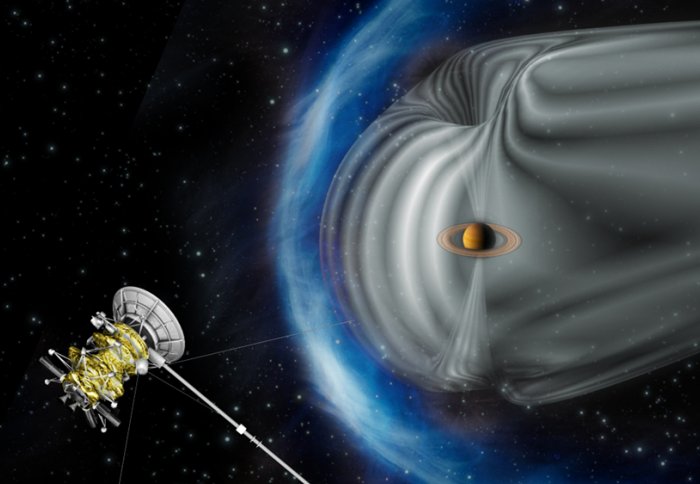16 September 2015
by Hayley Dunning
The Cassini space probe has detected unusually strong shock waves near Saturn, similar to those driven by supernovae.
Data from the probe as it encountered these very strong shock waves is helping Imperial College London scientists to understand exploding stars (known as supernovae) and the nature of plasma - the fourth state of matter that occupies 99 per cent of the visible universe.
Like Earth, Saturn generates its own magnetic field, known as the magnetosphere. When the supersonic solar wind, the stream of charged particles blown off from the Sun, interacts with the magnetosphere a shock wave is formed. This is called a ‘bow shock’, as it takes a shape much like the wave that forms in front of the bow of a moving ship.
The Cassini space probe crosses the bow shock of Saturn regularly as it orbits the planet, recording the strength of the magnetic field and the shock wave - using a magnetometer instrument built at Imperial.
POWERFUL SHOCKS
During its hundreds of crossings in its 11-year mission so far, Cassini has observed a handful of very strong shocks. It is the only spacecraft currently orbiting a planet in a region where the Mach numbers - a measure of shock strength - are significantly higher than at Earth.
Exploding stars, or supernovae, launch powerful shocks, but these are too far away to be directly measured. Instead, researchers rely on remote observations and simulations to understand the dynamics of these supernova remnants.
Now, however, researchers have gathered data from times when Saturn’s bow shock has been unusually strong, and comparable to the strength of supernova remnants. The Mach number of Earth’s bow shock is typically less than 10, whereas supernova shocks are in the 100s.
In a paper published today in Physical Review Letters, a team led by Imperial scientists analysed 54 of Cassini’s crossings of the bow shock where Mach numbers above 25 were recorded, including events that reached approximately Mach 100.
UNIQUE LABORATORY
Lead author Ali Sulaiman from the Department of Physics at Imperial said: “Saturn’s bow shock is proving to be a unique laboratory, giving us a rare insight into the physical processes driving ultra-strong shock waves. With Cassini’s ongoing exploration of Saturn’s environment, we have had the opportunity to encounter some of the strongest shocks ever.
“This has made these exotic supernova remnants, which are thousands of light-years away, somewhat within our reach. We have now been able to better determine the timescales of ions as they are reflected at the shock front – a fundamental process in such regimes.”
The nature of strong shock waves at Saturn is also helping researchers to better understand plasma, which is formed of electrons and ions that can move independently of each other, rather than being bonded as in solids, liquids and gases. It is difficult to control and study on Earth.
“Like studying waves in air or water, studying shock waves in plasma is fundamental to understanding its collective behaviour,” said Sulaiman. “Plasma shock waves are ubiquitous in the universe, for example from comets ploughing through the solar wind and solar flares erupting from the Sun. The Cassini data can help us bridge the gap between interplanetary and intergalactic regimes.”
-
'Quasiperpendicular high Mach number shocks' by Sulaiman, Masters, Dougherty, Burgess, Fujimoto, and Hospodarsky is published inPhysical Review Letters.













